- OR
- A heraldic term for the metal gold, generally (but not invariably) shown as
yellow in flags – but see note below (also ‘argent’, ‘embroider’,
‘metals’
and ‘rule of tincture’).
![[colour example]](../images/v/vxt-d555e.gif)
Please note that Or is sometimes seen as gold leaf or metallic paint, or in an embroidered design, as gold thread.
- ORARIUM
- See 'banderole 2)'.
- ORB
- A stylized globe usually surmounted by a cross, originally symbolic of Christ’s
dominion of this world and still largely (but by no means exclusively) a symbol of
monarchy – a globus cruciger (see also ‘crown’ and
‘sceptre’).
![[orb example]](../images/v/vxt-d5405.gif)
![[orb example]](../images/v/vxt-d5406.gif)
![[orb example]](../images/v/vxt-d5407.gif)
Flag of Vilar de Nantes, Portugal;
Flag of Remetschwil, Switzerland;
Flag of Portela Susã, Portugal
- ORBICULAR CROSS
- See ‘rounded cross’.
![[orbicular cross]](../images/v/vxt-d5178.gif)
Flag of Ferreira do Zêzere, Portugal
- ORDER IN COUNCIL
- See ‘royal order in council’.
![[Flag of Guernsey]](../images/v/vxt-d3311.gif)
Flag of Guernsey Established by Royal Order in Council
- ORDINARY
- The heraldic term used to describe a simple charge on a shield or banner of
arms as illustrated below.
![[chief example]](../images/v/vxt-d578.gif)
![[cross example]](../images/v/vxt-d1115a.gif)
![[pale example]](../images/v/vxt-d1115b.gif)
![[saltire example]](../images/v/vxt-d1115c.gif)
![[fess example]](../images/v/vxt-d1115d.gif)
![[pile example]](../images/v/vxt-d1115e.gif)
![[chevron example]](../images/v/vxt-d1115f.gif)
![[quarter example]](../images/v/vxt-d1115g.gif)
![[bend example]](../images/v/vxt-d1115h.gif)
Examples: Chief; Cross; Pale; Saltire; Fess; Pile; Chevron; Quarter; Bend
Please note that the honourable (or main) ordinaries are said to be the chief, cross, pale,
saltire, fess, pile, chevron, quarter and bend, and whilst these terms are briefly
described separately herein, however, it is suggested that a suitable glossary or dictionary
of heraldry be consulted for full or further details.
- ORDINARY PENNANT (or PENDANT)
- 1) See ‘masthead pennant 1)’
2) See ‘common pendant’).
![[common pendant]](../images/v/vxt-d3351.gif)
![[common pendant]](../images/v/vxt-d1279.gif)
Masthead/Ordinary Pennant, US; Common/Tricolour Pendant, England then UK 1661–c1850
- ORGANIZATIONAL COLOUR (or COLOR)
- See ‘parade flag 2)’
(‘colour 2)’ and
‘colours 2)’).
![[example]](../images/v/vxt-d2459.gif)
A Parade Flag of the Royal British Legion
- ORGANIZATIONAL FLAG
- 1) Generically, the flag of a non-profit making organization of national rather
than international significance, or of the national/district branch of an international
entity, for example the UK National Trust or the Boy Scouts of America (see also
‘international flag 1)’).
- 2) Specifically, in US army usage – see
‘parade flag 2)’ (also ‘colour 2)’
and ‘colours 2’).
![[National Trust, UK]](../images/v/vxt-d575.gif)
![[organizational flag]](../images/v/vxt-d4301.gif)
![[Boy Scouts of America]](../images/v/vxt-d575a.gif)
The National Trust, UK;
Boules Federation 2013–2015, Croatia
The Boy Scouts of America, US
- ORIFLAMME
- The gonfanon of St Denis, the war flag of medieval France and reputedly adapted
from that of Charlemagne. The exact design is uncertain and has been variously
described; however, it was almost certainly of red silk, possibly triple-tailed
and charged with a number of gold disks surrounded by red roses outlined in blue
– the auriflamma (see also ‘gonfanon’).
![[Oriflamme interpretation]](../images/v/vxt-d229.gif)
One interpretation of the Oriflamme
- ORIGINAL FLAG
- 1) See model flag.
- 2) A term that may also be used to describe the design upon which a flag
family was based, or that which formed the basis of any subsequent changes
– see flag family (also pan-African colours,
pan-Arab colours
and pan-Slavic colours).
![[model flag example]](../images/v/vxt-d2087.gif)
![[model flag example]](../images/v/vxt-d1447.gif)
Arab Revolt Flag 1917 and
Flag of Yukon Territory, Canada (design details established by type/model/original flag)
- ORLE (or ORLED)
- 1) The heraldic terms for a border that is inset from, and parallel to, the edges of a shield, banner
of arms or flag, and which may consist of an unbroken line or be made up by a number of separate charges
– for example an embattled orle as illustrated below – but see ‘inset border’
(also ‘border’, ‘charge’,
‘inset’ and
‘double-tressure’).
- 2) See ‘garland 1)’.
- 3) The heraldic terms that also covers a series of charges in a circular (or near circular) pattern
inset from the edges of a shield, banner of arms or flag, for example an orle of
‘mullets’ and the European Union flag
– but see also ‘in annulo’.
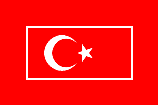

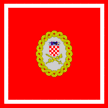
Flag of the Customs Administration, Turkey;
Flag of Palmela, Portugal;
Flag of a Naval General, Croatia
Please note with regard to 1) that some heraldic writers would consider the inset
narrow borders on the Turkish and Croatian flags illustrated above as a “tressure” – see ‘tressure’.
- ORNAMENTAL FLAGS (or FLAG)
- 1) See dress ship, to.
- 2) See ceremonial flag 1) (also "ornamented shield" [below] and unique flag).
The Editors suggest that the term "ornamental" should be restricted to the usage given above.
- ORNAMENTED SHIELD/FRAME
- See baroque shield and
renaissance shield (also "ornamental flags 2)" [above])

.gif)
Flag and Arms of Požega, Croatia
- ORTHODOX CROSS
- A term that describes a cross with three horizontal arms but whose lowest horizontal arm is canted, and considered to
be representative of the Eastern Orthodox Churches – a three-armed, triple-armed or triple cross
– but see papal cross (also
cross 2),
cross of Lorraine,
St. Nino's cross and
two and a half armed cross).
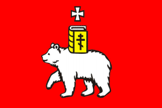

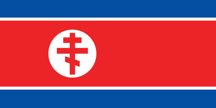
Flag of
Perm City, Russia; Example, Flag of the
Church of the Life Giving Trinity, Pyongyang (reddit.com)
- ORTHOGONAL
- 1) (Adj) Generically a term meaning rectangular or pertaining to or involving right angles.
- 2) (Adj) In vexillology a term which may be used when the arms of a saltire – or objects placed per
saltire – are set at right angles to each other (particularly when the flag upon which it –
or they – appear is rectangular rather than square) (see also
‘per saltire’ and
‘saltire’)
- 3) (Adj) In vexillology the term may also be used when the fork in the fly of a swallow-tailed
flag forms a right angle at the crutch (see also ‘crutch’, and
and ‘swallow-tail(ed)’).


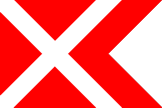
Flag of Chmeľnica, Slovakia;
Flag of Nenince, Slovakia;
Flag of Strážske, Slovakia
- OTSILA
- See ‘firesteel’.

Flag of the Serbian Orthodox Church
- OUTER BORDER
- The term that may be used when two borders appear within, or next to each other, to describe the one which appears
on the outside edge – see ‘inner border 1)’
(also ‘border’ and
‘inset border’).
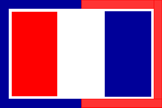
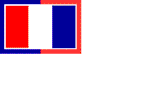

Naval Jack and Ensign 1790–1794, France; Naval Jack of
Croatia.
- OUTER EDGE
- A term that may be used in describing the edge of a hanging flag that is furthest from the building to which the pole is attached, and equivalent
to the top edge of a conventionally hoisted flag – but see ‘outer edges’ (also ‘hanging flag’
and ‘inner edge’).
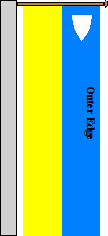
Please note that this term has been introduced by the Editors as no established
alternative could be found.
- OUTER EDGES
- A term that has been used to describe those edges (or design elements) of a flag
or pennant that do not lie (or are not present) along the hoist edge – for example a
border or a fringe – but see ‘border of three’ and ‘outer edge’
(also ‘border’,
‘fringe’ and
‘hoist 1)’).
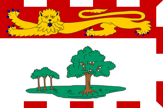


Flag of Prince Edward Island, Canada;
Flag of Ameliasburgh, Canada;
Flag of Bergen, Norway
Please note that this term has been introduced by the Editors as no established
alternative could be found.
- OUTRIGGER FLAG
- In German speaking, Central European and some other usage, the term
– and a direct translation of the German Auslegerflagge – which covers a
long vertically orientated (often but by no means invariably) commercial flag that is
fixed both along its hoist to the flagpole and along
the top edge to a horizontal arm or gallery – but see framed flag 1) (also
banner 2),
hanging flag,
gallery and
vertically hoisted flag 1)).

Please note that this type of flag is also a framed flag,
and should not be confused with a flag hung from an outrigger pole – see
hanging flag and banner 2) as referenced above.
- OUTRIGGER POLE
- The term for a flagpole that projects from the side of a building at an upward
angle, usually equipped with a halyard but is sometimes removable and fitted with
clips to attach the flag directly – an angled pole (see also ‘halyard’
and ‘tangle rod’).

- OVER
- 1) A term used to describe that stripe which is placed above another in a horizontally
striped flag, for example: red over white as illustrated below.
2) A term that is also used when one or more charges are placed above another or others – but see
‘above 1)’,
‘ensigned’ and
‘superimposed’.
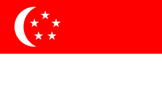

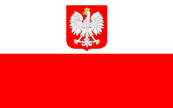
National Flag of Singapore;
National Flag of Austria;
State Flag of Poland
Please note with regard to 1) that use of this term is, strictly speaking, unnecessary,
since the standard method of describing such flags is from top to bottom. The Editors
suggest therefore, that it be restricted to bi-colours, and that the conventional terms
be retained for horizontal tricolours, tri-bands and multi-stripes, however, also please
note that its use in describing a flag of more than two stripes is not unknown.
- OVERALL (or OVER ALL)
- 1) On flags, a term used when a charge (often but by no means exclusively reaching the
edges of the flag) is placed over another design, as in for example, the bend on the
Artigas flag of Uruguay – but see overlaid (also charge
covering,
partially covering and
throughout).
- 2) In heraldry, the term can be used when a charge is placed over other charges,
or over a parti-coloured field, or when an inescutcheon or cartouche is placed over four or more quarters
– surtout – but see surmounted, by (also
escutcheon,
cartouche 1),
debruised,
inescutcheon,
quarter,
throughout).
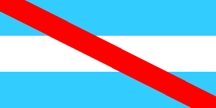
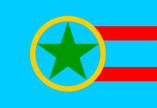
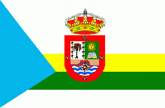
Flag of Entre Ríos, Argentina;
Flag of Tanna 1974;
Flag of Haria, Spain
Please note with regard
to 2), it is suggested that a glossary or dictionary or heraldry be consulted
with regard to comparative use of the terms “overall” and “surmounted by”.
- OVERLAID
- 1) On flags a term that may be used when one charge appears on top of another, or when that charge is
set against a patterned field – but see overall 1).
2) In heraldry see surmounted by 2) and overall 2) plus their following notes.
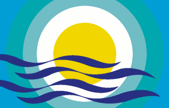
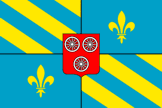
Flag of Lucena, Brazil;
Flag of Gagny, France
- OWNER ABSENT FLAG
- In US usage the practice, almost certainly obsolete, of flying a plain blue flag
from the starboard yardarm (or spreader) of a pleasure vessel when the owner is absent –
an absence pennant (see also
‘dinner flag’,
‘guest on board flag’,
‘meal pennant’,
‘yardarm’).

Owner Absent Flag, US
![[colour example]](../images/v/vxt-d555e.gif)
![[orb example]](../images/v/vxt-d5405.gif)
![[orb example]](../images/v/vxt-d5406.gif)
![[orb example]](../images/v/vxt-d5407.gif)
![[orbicular cross]](../images/v/vxt-d5178.gif)
![[Flag of Guernsey]](../images/v/vxt-d3311.gif)
![[chief example]](../images/v/vxt-d578.gif)
![[cross example]](../images/v/vxt-d1115a.gif)
![[pale example]](../images/v/vxt-d1115b.gif)
![[saltire example]](../images/v/vxt-d1115c.gif)
![[fess example]](../images/v/vxt-d1115d.gif)
![[pile example]](../images/v/vxt-d1115e.gif)
![[chevron example]](../images/v/vxt-d1115f.gif)
![[quarter example]](../images/v/vxt-d1115g.gif)
![[bend example]](../images/v/vxt-d1115h.gif)
![[common pendant]](../images/v/vxt-d3351.gif)
![[common pendant]](../images/v/vxt-d1279.gif)
![[example]](../images/v/vxt-d2459.gif)
![[National Trust, UK]](../images/v/vxt-d575.gif)
![[organizational flag]](../images/v/vxt-d4301.gif)
![[Boy Scouts of America]](../images/v/vxt-d575a.gif)
![[Oriflamme interpretation]](../images/v/vxt-d229.gif)
![[model flag example]](../images/v/vxt-d2087.gif)
![[model flag example]](../images/v/vxt-d1447.gif)




.gif)

























